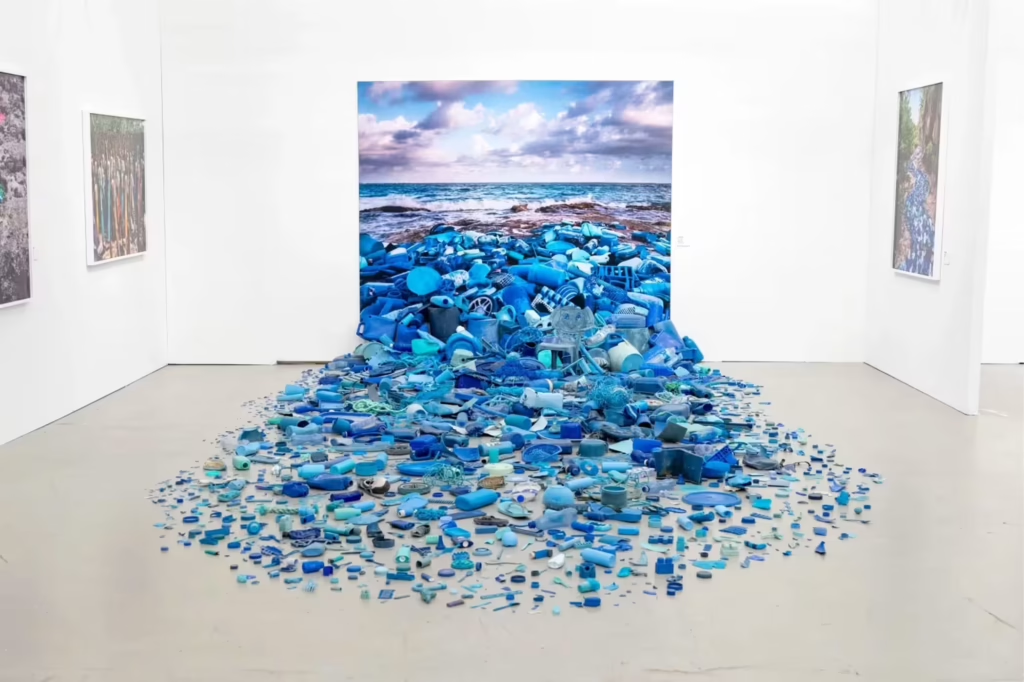The traditional perception of painting as mere aesthetics or retrospective historical representation is increasingly being challenged in the current era of global crises. In view of the pressing environmental problems of our time, the central question arises: How has painting changed in response to the growing environmental crisis, and what new tasks does it undertake to not only reflect but actively contribute to environmental protection?
The relationship between art and nature is historically deeply rooted. Already in Romanticism of the late 18th and early 19th centuries, which emerged as a reaction to the rational disenchantment of nature by the Enlightenment and the beginning of industrialization, nature became the central theme of artistic expression. Artists like Caspar David Friedrich with his iconic “Wanderer Above the Sea of Fog” or William Turner, known for his dramatic seascapes like “The Burning of the Houses of Lords and Commons,” glorified the “sublimity” and “wildness” of nature as a source of inspiration and spiritual retreat. In America, the Hudson River School saw untouched nature as a “second chance” for humanity. This artistic movement offered an escape from the “fumes of growing industrial centers” and laid the groundwork for modern nature conservation.
While Romanticism still depicted nature as a refuge and ideal, contemporary painting faces the urgent reality of massive environmental destruction. Since the 1960s and 70s, environmental art, also known as Eco-Art, has developed. This new movement goes beyond the mere depiction of nature and uses it as a medium to create awareness and call for action. This shows a fundamental shift in the understanding of art: from a contemplative, often idealized relationship with nature to a proactive, critical, and ethically motivated engagement with its destruction. The canvas thus transforms from a window to nature into a mirror of crisis and a catalyst for social change. This development underscores how art functions as an indicator of profound social upheavals and anxieties, expanding the boundaries of the medium to find new forms of expression and activism.

The Material Revolution, From Toxic Pigments to Sustainable Media
The escalating environmental crisis has prompted artists to fundamentally rethink the way they paint. This re-evaluation concerns not only the motif but also the materials used. Traditional paints and solvents often contain toxic chemicals such as volatile organic compounds (VOCs) and heavy metals like cadmium and lead. Their production also consumes significant natural resources. In this context, conscious material choice becomes an aesthetic, political, and ethical statement that makes the artwork itself a carrier of the message.
Use of Recycled Materials
Artists are increasingly integrating waste products and recycled materials into their paintings and installations. Examples include plastic waste, old fabrics, coffee grounds, or discarded photographs. This practice is not just a practical decision but a profound symbolic gesture. When artists use waste, the medium itself becomes the primary carrier of the message, forcing the viewer to confront the origin of the material and thus the problems of mass consumption and environmental pollution, even before the actual visual language is deciphered. This shifts the focus from pure representation to the material embodiment of the crisis.
A prominent representative of this movement is Vik Muniz, known for his complex and detailed works made from unconventional materials such as sugar, chocolate syrup, dust, magazine clippings, diamonds, and especially trash and waste. For his series “Pictures of Junk” and “Pictures of Garbage,” he arranged waste on huge warehouse floors. From an elevated perspective, often photographed with a camera from a crane, these arrangements recreated iconic scenes or famous paintings. The resulting photographs are the only permanent records of these ephemeral creations. Muniz often collaborated with local communities, such as the “catadores” (waste pickers) in Rio de Janeiro, whose livelihood is collecting recyclable materials. This collaboration highlights the dignity and despair of marginalized workers and draws attention to the social and ecological significance of waste. Muniz’s approach of transforming “the non-visual” – discarded waste – into art challenges the viewer’s perception and makes things we consider “just trash” suddenly appear meaningful.
Chris Jordan focuses his work on the visual impact of mass consumption and waste production. In “Intolerable Beauty: Portraits of American Mass Consumption,” he photographed huge piles of garbage in landfills and recycling centers. He transformed these “billowing piles” into “seductive abstractions,” whose beauty contradicts the reality of resource consumption. His series “Running the Numbers” translates consumption and waste statistics into visually accessible, composite images to illustrate the environmental impact of data. Jordan’s goal is for people to “feel these issues more deeply,” as he is convinced that this is key to change.
The artist Erik Jon Olson creates decorative quilts from single-use plastic. His works, such as “Now Streaming,” address the journey of plastic into the oceans, its decomposition into microplastics ingested by fish, and ultimately ending up in our own bloodstream. His art highlights the beauty of waste while simultaneously drawing attention to the profound problem of plastic pollution.
Use of Sustainable Paints and Pigments
In addition to recycled materials, artists are increasingly turning to natural pigments derived from minerals, earth, plants, or even insects. These are often non-toxic, biodegradable, and produce earthy, vibrant colors that establish a connection to nature.
A remarkable example is John Sabraw, an environmental artist and activist. He collaborated with a civil engineer to extract iron oxide sludge from the acidic mine water of Sunday Creek in Ohio. This sludge, a main component of many artist’s paints, is processed into pigments and sold as paints. The proceeds from the sale of these paints fund the environmentally friendly water purification process. This represents a transformation of environmental pollution into a sustainable solution. This project illustrates how art goes beyond mere awareness-raising and offers a model for a circular economy that transforms waste into value, thereby directly contributing to solving an environmental problem. It shows that art can not only criticize but also inspire innovative, sustainable solutions and business models that extend beyond the art context and initiate systemic changes.
Artists like Brittonie Fletcher and Modesto also use coffee grounds to create inks, dyes, or even paints. Modesto started by chance when he dipped his brush in coffee and has since made a career out of painting exclusively with coffee.
Technical and Artistic Challenges
Working with unconventional materials presents specific challenges:
- Responsible Sourcing: Even recycled materials have an ecological footprint due to collection, processing, and transport. There is a risk of “greenwashing” if sustainability claims are not transparently substantiated. The origin of the materials and the energy required for their preparation must be carefully checked to avoid hidden environmental costs.
- Durability: Biodegradable or unconventional materials can affect the longevity of an artwork. This raises questions about its cultural value and its acceptance in the art market, as potential buyers might hesitate if the artwork’s lifespan is limited. While some see impermanence as an artistic statement, this can affect the economic viability for artists.
- Artistic Freedom versus Environmental Principles: Artists must find a compromise between their creative vision and the environmental impact of their material choices. This may mean adapting the original concept or exploring innovative, environmentally friendly materials that allow for a similar aesthetic. These challenges require ingenuity and a willingness to explore alternative approaches.

The Canvas as a Manifesto, Artworks that Educate and Arouse
Contemporary painting serves as a crucial medium to draw attention to environmental destruction and climate change. It translates complex scientific data into visually accessible and emotionally appealing artworks that establish a deeper connection with the viewer than facts and figures alone could. Art breaks through the apathy of everyday life and appeals to the senses and emotions, giving it a unique ability to overcome the cognitive barrier and establish a deeper, affective connection to the problem, which is essential for mobilizing engagement.
Addressing Melting Glaciers and Climate Change
Zaria Forman creates hyperrealistic pastel drawings of icebergs, glaciers, and seas. Her works are a tribute to the beauty of nature and at the same time a warning about its fragility. Forman travels to remote landscapes such as Greenland and the Maldives to document the changing geography. She deliberately chooses to depict beauty rather than destruction to create an emotional connection and inspire action. Her technique of smudging layers of pigment with her hands and fingers gives the works an immediate, tactile quality. Her project “Ice to Islands” documents vanishing landscapes and the stories of affected people. Her work serves as a “record of landscapes in flux,” preserving the memory of what is being lost while simultaneously projecting possible dystopian futures if no action is taken.
Olafur Eliasson is known for his large-scale installations that use natural phenomena such as light, water, and air to challenge viewers’ perceptions. His work “Ice Watch” (2014) is a striking example: he transported 100 tons of ice from a Greenlandic fjord to Copenhagen (later Paris), where the twelve ice blocks, arranged in a clock formation, slowly melted. This allowed visitors to physically and viscerally experience climate change – a “physical countdown.” Eliasson emphasizes that this experience reaches people in a way that reports and data cannot, motivating them to act. His art aims to blur the lines between artwork and audience and to encourage critical reflection on the environment.
Artists Jim Schantz and Peter Bremers presented their exhibition “Homage to the Glacier,” which included oil paintings and glass sculptures. These works are the result of their travels to the Vatnajökull glacier in Iceland. They act as “witnesses” to the changes and translate the beauty of the ice into abstract forms that reflect the transformation of the glaciers.
Julian Charrière‘s works on polar landscapes, such as “The Blue Fossil Entropic Stories III,” in which he attempts to melt an iceberg with a blowtorch, or his sculptures made of stones carried by glaciers, which he fills with precious metals (“Not All Who Wander Are Lost”), address the fragility and disappearance of the “memory of the sky” in the melting ice. Charrière emphasizes the need for art that helps to make sense of facts.
Addressing Ocean Pollution and Biodiversity
Chris Jordan‘s “Midway” project shockingly illustrates the consequences of mass consumption by presenting images of albatross carcasses whose stomachs are filled with plastic waste. These images are a direct, unbearable look at the innocent victims of our excess and aim to convey the urgency of behavioral change.
Benjamin von Wong created installations such as a mermaid on 10,000 plastic bottles to draw attention to the “Great Pacific Garbage Patch.” He uses “fiction to tell the truth,” as this is often more effective in touching people and sparking their curiosity.
Performance artist Anne-Katrin Spiess staged “Death by Plastic,” a funeral for the planet, in which a person is covered in plastic waste in a plexiglass coffin. This aims to draw attention to ocean pollution and the absorption of microplastics into the human body.
Other artists such as Angela Haseltine Pozzi (“Washed Ashore”), Alejandro Duran (“Washed Up Project”), and Liina Klauss use collected plastic waste from beaches to create sculptures and installations that make the reality of marine pollution visually tangible.
Psychological Impact and Role as a “Wake-Up Call”
These artworks evoke empathy and a sense of urgency by transforming the abstract threat into a personal, often painful experience. They function as a “wake-up call” and a visual complement to scientific reports, highlighting the emotional dimension of the crisis and encouraging reflection on one’s own role. The depiction of melting glaciers or albatrosses filled with plastic serves not only as documentation of the current state of environmental destruction but also as a “record of landscapes in flux.” They preserve the memory of what is being lost and simultaneously project possible dystopian futures if no action is taken. This dual function – preserving the past and warning for the future – gives art a profound meaning and increased urgency that goes beyond mere documentation.

Beyond the Gallery, Painting as Activism
To achieve a broader impact, painting is increasingly leaving the traditional exhibition space. Public art, especially street art and murals, plays a crucial role in the environmental movement, as it integrates environmental themes into people’s daily lives and makes them more tangible.
Street Art and Murals in Environmental Protection
These publicly accessible artworks in cities and communities create awareness and stimulate local discussions. They use the visibility of public space to spread messages that would otherwise remain hidden in galleries. This accessibility allows for a wider dissemination of environmental messages and promotes local engagement in a way that institutional art cannot. Art thus becomes an integral part of the urban dialogue on environmental issues.
Some impressive examples include:
- Banksy‘s work “I Remember When All This Was Trees” in Detroit comments on the loss of natural habitats and urban decay.
- Bordalo II creates striking 3D animal sculptures from discarded materials, contrasting the beauty of wildlife with the ugliness of our throwaway culture.
- Pejac‘s work “The world going down the drain” in Santander, Spain, is a simple but powerful statement about dependence on fossil fuels.
Organizations like Street Art for Mankind (SAM) work specifically with the United Nations Environment Programme (UNEP) and the Food and Agriculture Organization (FAO) to amplify the messages of the UN Decade on Ecosystem Restoration. Artists like Lula Goce, Martin Ron, Carlos Alberto, Nomad Clan, Victor Ash, Adry del Rocio, Emily Ding, Dulk, Super A, and Vesod create large-scale murals worldwide that address urban forests, oceans, and biodiversity and call for action. The accompanying “Behind the Wall” app allows the public to learn the stories behind the artworks and get involved, further democratizing the environmental message.
Collaboration of Artists with Environmental Organizations and Scientists
These synergies significantly increase the reach and influence of art. The combination of art and science enables a transdisciplinary approach to complex environmental problems. Artists translate complex scientific findings into an emotional and aesthetic language that is understandable and relatable to the general public. At the same time, scientists can benefit from the creative problem-solving abilities of artists, leading to innovative, multidisciplinary solutions for environmental problems. Art thus becomes an indispensable actor in the transdisciplinary fight against the environmental crisis.
- Betty Beaumont‘s work “Ocean Landmark” (1978-80) is an early example of such collaboration. She transformed power plant waste into an artificial reef in the Atlantic by collaborating with scientists and engineers. This broke down the boundaries between disciplines and showed new, integrated ways of working to solve pressing problems.
- John Sabraw‘s cooperation with a civil engineer to convert mine water pollution into paints is a prime example of the practical application of art-science synergies.
- The “Art x Climate” project, as the first art gallery included in the US National Climate Assessment (NCA), used art to make the topic of climate change more accessible and personal to a wider audience. It fostered respect between art and science and demonstrated art’s potential to enable new collaborations and involve more people in the climate discussion.
Painting in the 21st century has undergone a remarkable transformation: from a mere depiction of nature, it has evolved into a powerful medium of environmental awareness. It has redefined its materiality by using recycled materials and sustainable pigments, thereby integrating a deeply ethical dimension into the art-making process. This conscious choice of materials makes the medium itself a messenger, forcing the viewer to confront the causes and consequences of human actions.
At the same time, painting serves as a compelling manifesto that makes complex scientific data emotionally accessible and stirs viewers through visual representations of climate change and environmental destruction. It builds a bridge between abstract facts and human empathy, making the urgency of the crisis tangible on a deep, affective level. Furthermore, painting has grown beyond traditional exhibition spaces and has evolved into a form of direct activism through street art and collaborations with scientists. It democratizes the environmental message by bringing it into public spaces and creating interdisciplinary synergies that drive innovative solutions.
Painting in the 21st century is thus not only an aesthetic but also a deeply ethical and social discipline. It challenges the viewer to rethink their role in the ecological system and to take responsibility. The integration of sustainable materials and the thematic engagement with the environmental crisis reposition painting as a powerful tool for social change. It is a catalyst for dialogue, empathy, and collective action. In times of global crises, art can no longer merely depict the world. It must actively participate in its salvation by creating awareness, evoking emotions, and inspiring people to become part of the solution. The canvas is thus not only a mirror of the crisis but also a window to hope and an urgent call to action.









